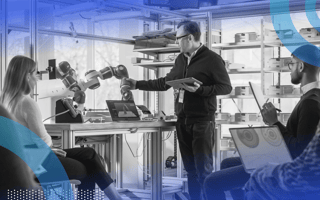ChatGPT writes symphonies. DALL-E creates masterpieces. Sora generates Hollywood-quality films. Yet, your warehouse robot breaks when someone moves a box three inches to the left.
Generative AI conquers digital realms at breathtaking speed. Language models master everything from poetry to quantum physics. Image generators birth photorealistic worlds from whispered prompts. But step into the physical world? Robotics feels painfully stuck in the past.
The problem isn’t hardware, it's philosophy.
Understanding Vision-Language-Action in Robotics
Vision-language-action (VLA) is a learning model for robotics that emphasizes processing real-world data of images and corresponding actions to develop a sophisticated understanding of physical interactions. It uses generative techniques, including diffusion models to predict complex sequences of movements based on visual understanding and contextual reasoning.
While AI researchers embrace massive data sets and emergent intelligence, robotics clings to 2017’s greatest hits: hand-crafted rules, tiny data sets and rigid programming. It is the equivalent of trying to build ChatGPT with Excel spreadsheets.
Why can an AI discuss Shakespearean tragedy one moment and debug Python code the next, while a “smart” robot still fumbles picking up your coffee mug when the lighting changes? The disconnect isn’t just frustrating. It’s a trillion-dollar opportunity disguised as technical lag.
The companies that crack this code will not just improve robots. They will unleash the same transformative force that turned text prediction into artificial intelligence.
Robotics Is Stuck in a Pre-Scaling Mindset
Today’s robotics looks exactly like AI before its watershed moment: hand-engineered, overfitted and fundamentally unscalable.
The industry remains obsessed with artisanal approaches. Hand-tuned policies crafted for microscopic use cases. Custom data collection that costs fortunes and produces small data sets. Hard-coded architectures loaded with brittle assumptions that shatter the moment reality intervenes.
Reinforcement learning loops, robotics’ current darling, epitomize this backward thinking. These approaches can achieve impressive performance in simulation environments where variables remain controlled and edge cases can be systematically eliminated. But deploy them in a messy reality where variables no longer stay polite? It is not a good outcome.
Consider the absurdity: engineers spend months perfecting a robot that can stack boxes in perfect laboratory conditions, then act surprised when it fails in an actual warehouse with uneven floors or varying lighting. This isn’t engineering, it’s wishful thinking disguised as precision.
These methods simply can’t scale to real-world diversity. The same scaling laws that govern language model performance — where larger models trained on more diverse data consistently demonstrate superior generalization — apply equally to robotics. Yet, the industry continues pursuing approaches that explicitly reject the scaling paradigm in favor of narrow optimization.
Vision-Language-Action: Less Policies, More Generative AI
Stop building better rules. Start building smarter machines, faster and at scale. Robots don’t need more sophisticated programming. They require the same revolutionary approach that created ChatGPT and DALL-E.
The solution? vision-language-action (VLA) models, or simply put, generative AI for the physical world. VLAs flip robotics on its head. These systems learn by observing vast amounts of real-world data, processing images and corresponding actions to develop a sophisticated understanding of physical interactions. Rather than relying on hand-crafted policies, VLAs use generative techniques, including diffusion models similar to those powering image generation, to predict complex sequences of movements based on visual understanding and contextual reasoning.
When you tell a VLA-powered robot to “carefully place the fragile item on the shelf,” it understands both the linguistic nuance and the physical implications.
This enables something revolutionary: generalization. Instead of engineering separate solutions for every task variation, VLAs learn adaptable features that transfer across situations. One model handles warehouse logistics, surgical assistance, and home organisation — not because it was programmed for each, but because it learned deep principles of physical interaction.
The mantra driving this transformation could not be simpler: “Less policies, more generative AI.”
The focus shifts from crafting specific behaviors to building adaptable intelligence. From narrow optimization to broad capability. From human assumptions to learned patterns. It is the same revolution that transformed language understanding, applied to physical intelligence.
VLA’s technical implementation leverages late fusion multimodal architectures, projecting visual information and action sequences into shared representational spaces. Diffusion models generate continuous action trajectories rather than discrete outputs. This approach scales across robot configurations through latent action representations.
But the real breakthrough is not technical — it is conceptual. VLAs represent the first serious attempt to apply modern AI’s core insight to robotics: intelligence emerges from scale, not engineering cleverness.
Build The Infrastructure, Or Watch Others Win
The first trillion-dollar robotics company will not manufacture robots. It will manufacture intelligence.
This distinction matters hugely. Hardware commoditizes. Intelligence differentiates. The companies building the most capable artificial brains will capture disproportionate value, just as OpenAI and Google Gemini dominate AI despite not manufacturing chips or building data centers.
Scaling laws are merciless and universal. Larger models trained on more diverse data consistently outperform smaller, specialized alternatives. This is not incremental improvement, but exponential advantage compounding over time.
To industry leaders, stop thinking pilots and start thinking platforms. Invest in comprehensive data collection infrastructure and general-purpose AI frameworks. The companies treating robotics as isolated point solutions will miss the compounding returns from integrated approaches. Build data moats, not application demos.
Investors must recognize that today's impressive hardware demonstrations matter less than tomorrow's data and modeling capabilities. The winners will be companies building infrastructure to collect, process, and learn from comprehensive real-world robotics interactions. Look for teams that understand scaling laws, not just mechanical engineering.
The transformation is inevitable. The timeline is compressing. The value creation will be massive.
Robotics stands where natural language processing stood in 2017 — on the cusp of explosive capability gains that will reshape entire industries. The question is not whether this revolution will happen. It is whether you will be driving it or desperately trying to catch up.
The companies embracing generative AI principles — scale, diversity and generalization over narrow optimization — will define the next chapter of intelligent automation. Those clinging to artisanal approaches will become footnotes in the history of artificial intelligence.





